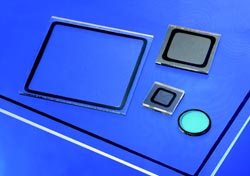Laser Glass Soldering: Resource–efficient Packaging of Temperature-sensitive Large Component Groups

Soldered Glass/Glass, Glass/MAM, Glass/Silicon, Glass/LTCC, Glass/ITO components.<br>Picture Source: Fraunhofer ILT, Aachen<br>
Unlike other processes, the laser beam is able to apply energy to a limited space in order to melt the glass solder precisely, thus generating a bond with long-term, stable hermeticity. The Fraunhofer Institute for Laser Technology ILT is developing the appropriate irradiation strategies and processing heads to achieve this.
Sensitive component groups such as optical sensors in medical technology, OLED components or dye solar cells require reliable encapsulation so that neither water nor oxygen can reach the interior of the component, thereby possibly impairing its functionality. Conventionally, such components are joined with anodic or glass-frit bonding or they are simply glued together. These bonds, however, are not stable enough over the long term. In addition, the entire component group is heated when it is bonded, which is why the process is not suitable for bonding temperature-sensitive components.
Scientists at the Fraunhofer ILT have developed a process that enables them to reduce the total heating of the component to be encapsulated to a minimum and, thus, prevent thermally induced stress in the process zone. By using laser-based joining with glass solder, the experts in Aachen can hermetically join temperature-sensitive glass/glass as well as glass/ceramics components groups which exhibit long-term stability. They have developed the process to such an extent that large components can also be encapsulated.
Laser-based Joining with Glass Solder
During laser-based glass soldering, the laser beam is guided precisely over the workpiece and applies the energy solely into the glass solder itself to melt it. The substrates to be joined are heated only via heat conduction to wet them; this way, the overall heating of the component group can be reduced to a minimum. An appropriate radiation approach for this is quasi-simultaneous laser soldering: a highly dynamic 2D scanner system guides the laser beam over the solder contour many times at a high speed and evenly heats the entire glass solder contour up to processing temperature by means of a laser power-time profile. After both joining pairs have been bonded, the temperature in the processing zone is lowered according to the profile without creating stress.
The quasi-simultaneous laser soldering is technically restricted by the maximum processing field size of the focusing optics as well as limited, from an economic point of view, by the laser power required, PL>1kW, when substrate sizes of 100 x 100 mm² are joined. Current processing approaches unify the resource-efficient energy input of this quasi-simultaneous process guidance with the size and geometry freedom of continuous processing optics.
New Geometrical Freedom for Temperature-sensitive Component Groups
The so-called contour soldering with energy input adapted laterally to feed movement enables, for the first time, large substrates to be joined at significantly lower laser power. For contour soldering, continuous beam sources are adequately dimensioned at PL
Viewing the Entire Production Chain
The team at the Fraunhofer ILT will design the entire production chain for its partners. From initial steps to prepare the process, such as the selection of an appropriate glass solder, via the application of the glass solder by means of screen printing all the way to the pre-vitrification of the pairs to be joined in a convection oven. Especially for laser-based glass soldering, the researchers have developed processing heads as well as positioning and clamping technologies to guarantee homogenous and reproducible packaging in either ambient or inert protective gas atmospheres.
Fraunhofer ILT at the Hannover Messe
In Hall 17 at the IVAM joint stand C50.13 at the Hannover Messe from April 8 to 12, 2013, our experts will be exhibiting component groups that were joined using laser-based glass soldering: for example, sensor housings with bonds of glass/silicon and glass/ceramics as well as glass/glass bonds with ITO layers.
Contacts
Elmar Gehlen, Dipl.-Ing.
Group Micro Joining
Telephone +49 241 8906-640
elmar.gehlen@ilt.fraunhofer.de
Heidrun Kind, Dipl.-Ing.
Group Micro Joining
Telephone +49 241 8906-490
heidrun.kind@ilt.fraunhofer.de
Dr. Alexander Olowinsky
Leader Group Micro Joining
Telephone +49 241 8906-490
alexander.olowinsky@ilt.fraunhofer.de
Fraunhofer Institute for Laser Technology ILT
Steinbachstraße 15
52074 Aachen, Germany
Media Contact
More Information:
http://www.ilt.fraunhofer.deAll latest news from the category: Process Engineering
This special field revolves around processes for modifying material properties (milling, cooling), composition (filtration, distillation) and type (oxidation, hydration).
Valuable information is available on a broad range of technologies including material separation, laser processes, measuring techniques and robot engineering in addition to testing methods and coating and materials analysis processes.
Newest articles

An Endless Loop: How Some Bacteria Evolve Along With the Seasons
The longest natural metagenome time series ever collected, with microbes, reveals a startling evolutionary pattern on repeat. A Microbial “Groundhog Year” in Lake Mendota Like Bill Murray in the movie…

Witness Groundbreaking Research on Achilles Tendon Recovery
Achilles tendon injuries are common but challenging to monitor during recovery due to the limitations of current imaging techniques. Researchers, led by Associate Professor Zeng Nan from the International Graduate…

Why Prevention Is Better Than Cure—A Novel Approach to Infectious Disease Outbreaks
Researchers have come up with a new way to identify more infectious variants of viruses or bacteria that start spreading in humans – including those causing flu, COVID, whooping cough…



